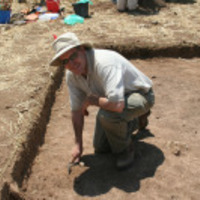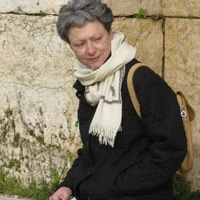
VASILIKI KASSIANIDOU
Prof. Vasiliki Kassianidou studied at Bryn Mawr College, USA where she did a double major in Chemistry and Classical and Near Eastern Archaeology. She received her Bachelor degree with a distinction (Cum Laude) in 1989. She continued her studies at the Institute of Archaeology, University College London where she received her doctoral degree on Archaeometallurgy in 1993.
She worked as a post-doctoral research fellow at the Institute of Archaeology, UCL, (1993) and in 1994 she joined the faculty of the Department of History and Archaeology of UCY, where she has been teaching Environmental Archaeology and Archaeometry. In June 2015 she was appointed Director of the Archaeological Research Unit (ARU) by the Senate of the UCY. Prof. Kassianidou has been active in the administration of UCY serving as vice-chair of the Department of History and Archaeology, as a member of the UCY Senate and as a member of various committees. She is also a member of the Cyprus National Commission for UNESCO. From 2014 -2016 she served as the President of the Board of Trustees of the Cultural Foundation of the Bank of Cyprus.
Her research is focused on ancient technology and specifically the production and trade of Cypriot copper through antiquity but also on the impact of this industry on the Cypriot landscape and environment. She has taken part and directed a number of field and analytical projects regarding her fields of expertise and has an extensive list of publications which include two edited volumes, three co-authored volumes and over fifty articles in peer reviewed journals, edited volumes and conference proceedings.
Prof. Kassianidou has coordinated a number of research projects with funding from the Research Promotion Foundation or the European Union (in FP7 and H2020). The most important of these was the four year project entitled “New Archaeological Research Network for Integrating Approaches to Ancient Material Studies (NARNIA)” which she set up and coordinated. NARNIA was a Marie Curie Initial Training Network which fell under the People programme of FP7. It consisted of a consortium of nine partners from six different countries. With a budget of 4.6 million euros and 100% financing from the Research Executive Agency (REA) NARNIA was and perhaps still is the largest funded project ever to be granted by the REA to Cyprus and the largest project to receive funding from the European Commission in the fields of archaeology and archaeological sciences. She has aloso coordinated a Marie Curie Individual Fellowship (656148 — PRENET — H2020-MSCA-IF-2014) with a budget of 151,000 euros and is currently coordinating a new Marie Curie Individual Fellowship which will start in September 2017 (750904 — GLAZE — H2020-MSCA-IF-2016) with a budget of 151,648 euros. Currently she is one of the members of the University of Cyprus in the consortium of the MedSTACH project in which the Institute of Archaeology, UCL is also participating. The MedSTACH project aims to establish Cyprus as an excellence hub in archaeology and cultural heritage in the Eastern Mediterranean region, capitalizing on multidisciplinary research and technological innovation.
She worked as a post-doctoral research fellow at the Institute of Archaeology, UCL, (1993) and in 1994 she joined the faculty of the Department of History and Archaeology of UCY, where she has been teaching Environmental Archaeology and Archaeometry. In June 2015 she was appointed Director of the Archaeological Research Unit (ARU) by the Senate of the UCY. Prof. Kassianidou has been active in the administration of UCY serving as vice-chair of the Department of History and Archaeology, as a member of the UCY Senate and as a member of various committees. She is also a member of the Cyprus National Commission for UNESCO. From 2014 -2016 she served as the President of the Board of Trustees of the Cultural Foundation of the Bank of Cyprus.
Her research is focused on ancient technology and specifically the production and trade of Cypriot copper through antiquity but also on the impact of this industry on the Cypriot landscape and environment. She has taken part and directed a number of field and analytical projects regarding her fields of expertise and has an extensive list of publications which include two edited volumes, three co-authored volumes and over fifty articles in peer reviewed journals, edited volumes and conference proceedings.
Prof. Kassianidou has coordinated a number of research projects with funding from the Research Promotion Foundation or the European Union (in FP7 and H2020). The most important of these was the four year project entitled “New Archaeological Research Network for Integrating Approaches to Ancient Material Studies (NARNIA)” which she set up and coordinated. NARNIA was a Marie Curie Initial Training Network which fell under the People programme of FP7. It consisted of a consortium of nine partners from six different countries. With a budget of 4.6 million euros and 100% financing from the Research Executive Agency (REA) NARNIA was and perhaps still is the largest funded project ever to be granted by the REA to Cyprus and the largest project to receive funding from the European Commission in the fields of archaeology and archaeological sciences. She has aloso coordinated a Marie Curie Individual Fellowship (656148 — PRENET — H2020-MSCA-IF-2014) with a budget of 151,000 euros and is currently coordinating a new Marie Curie Individual Fellowship which will start in September 2017 (750904 — GLAZE — H2020-MSCA-IF-2016) with a budget of 151,648 euros. Currently she is one of the members of the University of Cyprus in the consortium of the MedSTACH project in which the Institute of Archaeology, UCL is also participating. The MedSTACH project aims to establish Cyprus as an excellence hub in archaeology and cultural heritage in the Eastern Mediterranean region, capitalizing on multidisciplinary research and technological innovation.
less
Related Authors
Thilo Rehren
The Cyprus Institute
Anna Maria Sdralia
Universidad de Granada
Sturt Manning
Cornell University
Moritz Jansen
University of Pennsylvania
Alexander Apostolides
European University Cyprus
Maria Iacovou
University of Cyprus
InterestsView All (9)









Uploads
PAPERS by VASILIKI KASSIANIDOU
Museum together with artefacts from the private collection of
Nikos Charalambides, a mining engineer and director of the
Kambia Mines company and others from the collection of the
Hellenic Mining Corporation (HMC) which were also donated
to the Department of Antiquities. The assemblage is unique
in that it includes artefacts made of organic materials, which
usually do not survive in archaeological sites in Cyprus. The
aim of this paper is to present the different types of mining
tools recovered but the restrictions regarding to the size of
this publication does not allow extensive discussion. This will
be published later on together with the results of radiocarbon
dating of some of these objects that we were allowed to
sample.
wreck. According to ancient sources, however, Cypriot copper was traded to the East already since the nineteenth century BC: in texts dating to the Old Babylonian period and found at Mari, Babylon and Alalakh there are several mentions to cop
per from Alashiya, the name by which Cyprus was known to her neighbours. The texts show that metal from the island was traded all the way to Babylon. It was probably exchanged for gold, tin, silver and lead which were not locally available but are found in tombs of this period. In what form, however, was Cypriot copper traded in the earlier phases of the Bronze Age? The aim of this paper is to discuss Cypriot ingots and especially the early forms of metal ingots produced on the island.
Museum together with artefacts from the private collection of
Nikos Charalambides, a mining engineer and director of the
Kambia Mines company and others from the collection of the
Hellenic Mining Corporation (HMC) which were also donated
to the Department of Antiquities. The assemblage is unique
in that it includes artefacts made of organic materials, which
usually do not survive in archaeological sites in Cyprus. The
aim of this paper is to present the different types of mining
tools recovered but the restrictions regarding to the size of
this publication does not allow extensive discussion. This will
be published later on together with the results of radiocarbon
dating of some of these objects that we were allowed to
sample.
wreck. According to ancient sources, however, Cypriot copper was traded to the East already since the nineteenth century BC: in texts dating to the Old Babylonian period and found at Mari, Babylon and Alalakh there are several mentions to cop
per from Alashiya, the name by which Cyprus was known to her neighbours. The texts show that metal from the island was traded all the way to Babylon. It was probably exchanged for gold, tin, silver and lead which were not locally available but are found in tombs of this period. In what form, however, was Cypriot copper traded in the earlier phases of the Bronze Age? The aim of this paper is to discuss Cypriot ingots and especially the early forms of metal ingots produced on the island.
The volume contains 42 chapters by both established and emerging scholars. They present data from new sites that challenge prior perspectives on the timing and direction of Neolithic expansion across Southwest Asia. While the origins of the earliest Neolithic (PPNA) lithic technology in the preceding Epi-Palaeolithic (Natufian) illustrate continuities in the different regions of the Levant, these new data support polycentric or non-centric perspectives of Neolithic development, and contribute to a more complex, multi-linear assessment of diffusion. The range of papers present recently discovered evidence documenting an earlier Neolithic expansion to the Southern Levant along routes including the desert interior, and the PPNA expansion to Cyprus, highlighted by parallel lithic traditions and dependent on Neolithic advances in seafaring. Neolithisation of the Caucasus and the Aegean is examined in terms of the spread of complex pressure modalities at the end of the PPN and in the early PN period. The pace and direction of Neolithic change preserved in accumulated corpuses of lithic data in all areas of the Near East begin to show more complex timing in the adoption of Neolithic technologies, distinctions in local contexts and tool adaptation to advances in agriculture. Together these studies provide an up-to-date and multifaceted perception of this transformative period of change.
The book will hopefully act as a testimony of the individual and collective work that has been conducted for the past four years by all our fellows and members of the NARNIA partnership. The papers presented by our fellows in this publication, are short summaries of their research, which will be more extensively published in peer-reviewed journals and, hopefully, monographs following the submission of their doctoral theses. We envisage this book to serve as a medium for people outside the network to become acquainted with the research that was undertaken by our fellows under the supervision of the NARNIA scientific staff, but also as a token of the hard work, dedication and passion of all the people that worked hard for NARNIA to become a milestone in archaeological research.
Main web page: https://place-itn.cyi.ac.cy/